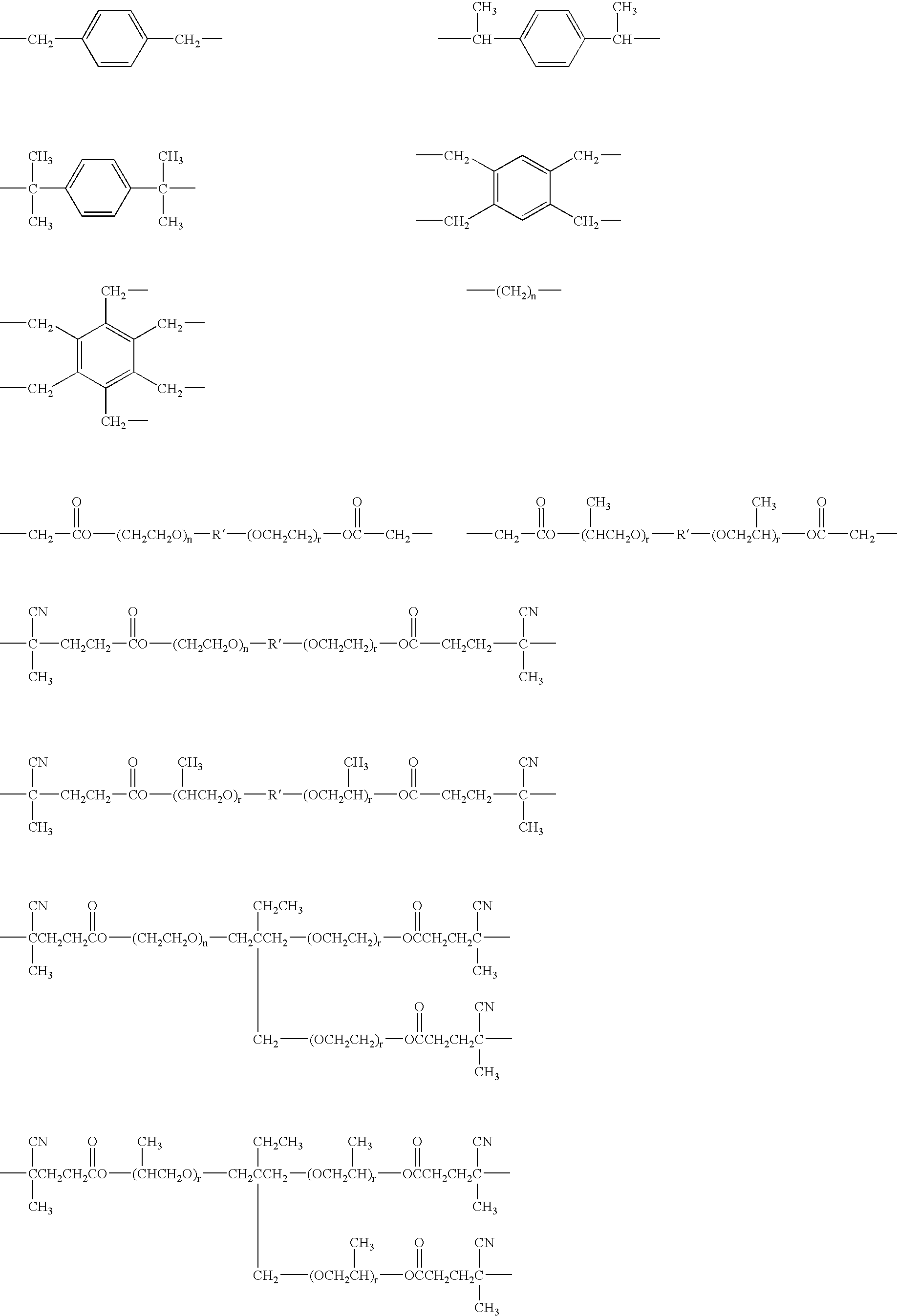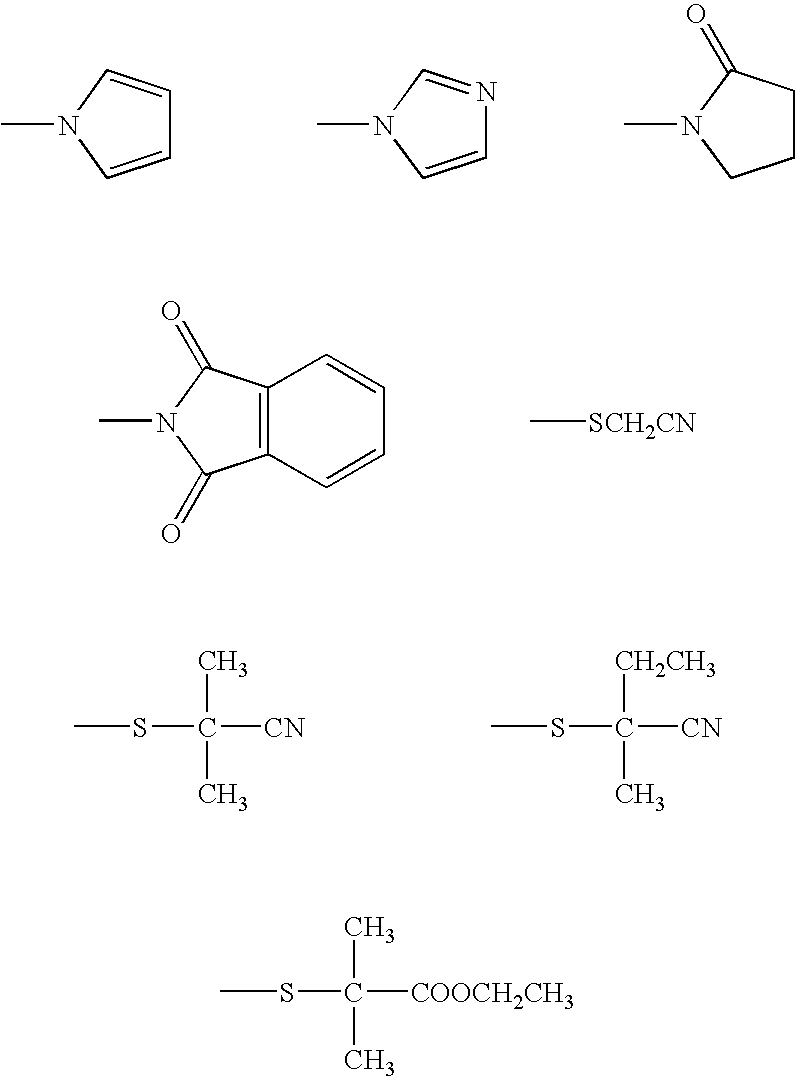Polyurethane polymer
a polymer and polymer technology, applied in the field of polyurethane polymer, can solve the problems of insufficient durability, insufficient weatherability, heat resistance, heat resistance, etc., and achieve the effects of simple and economical production, excellent oil resistance, and light resistan
- Summary
- Abstract
- Description
- Claims
- Application Information
AI Technical Summary
Benefits of technology
Problems solved by technology
Method used
Image
Examples
example 2
[0076] Into a 1 L reactor equipped with an agitator, a thermometer, a nitrogen gas inlet tube, and a reflux condenser tube, was placed 181 g of n-butyl acrylate as a vinyl monomer, 40 mg of 1,1'-azobis(1-cyclohexaneca-rbonitrile) as a polymerization initiator, 11.2 g of a compound represented by formula (3): 11
[0077] as a thiocarbonylthio group-containing compound, and 300 mL of toluene as a solvent, and the reactor was nitrogen-purged. The reaction solution was heated at 90.degree. C. for 40 hours while being stirred. The reaction solution was sampled, and the production of a polymer was confirmed. .sup.1H NMR measurement confirmed that thiocarbonylthio groups were introduced at both ends of poly(n-butyl acrylate), and the introduction rate was 97% on the both-ends basis.
[0078] Next, 30 g of diethylamine as a processing agent was added thereinto, followed by stirring at 30.degree. C. for 8 hours. The remaining diethylamine and toluene were removed by distillation under reduced pres...
example 3
[0080] Into a 1 L reactor equipped with an agitator, a thermometer, a nitrogen gas inlet tube, a reflux condenser tube, and a dropping funnel, was placed 410 mg of sodium dodecylsulfonate as an emulsifier and 400 g of distilled water, and the reactor was nitrogen-purged while the mixture was being stirred at 80.degree. C. Next, 5.4 g of a compound represented by formula (4): 12
[0081] as a thiocarbonylthio group-containing compound, which was dissolved in 25.6 g of n-butyl acrylate as a vinyl monomer, was added into the reactor, followed by stirring at 80.degree. C. for 20 minutes under nitrogen flow. As a polymerization initiator, 432 mg of 4,4'-azobis(4-cyanovaleric acid) together with 25 g of distilled water was further added thereinto. Stirring was performed at 80.degree. C. for 30 minutes, and then a mixed solution of 51.3 g of n-butyl acrylate and 52.1 g of 2-methoxyethyl acrylate was dripped from the dropping funnel for over 1.5 hours. After dripping was completed, the mixture...
example 4
[0084] Styrene (45.1 g) as a vinyl monomer and a compound represented by formula (5): 13
[0085] (273 mg) as a thiocarbonylthio group-containing compound were weighed and placed into a 200 mL reactor equipped with an agitator, a thermometer, a nitrogen gas inlet tube, and a reflux condenser tube, and the reactor was nitrogen-purged. Stirring was performed at 100.degree. C. for 20 hours, and thereby a polymer was produced. The polymer was a star polymer with four arms, and it was confirmed by .sup.1H NMR measurement that the polymer had a thiocarbonylthio group at each end. The introduction rate of thiocarbonylthio groups was 78% on the all-ends basis.
[0086] Toluene (100 mL) and monomethylamine (3.1 g) as a processing agent were added thereinto, followed by stirring at 0.degree. C. for 15 hours. The solvent was removed by distillation under reduced pressure, and thereby a star polymer with four arms was produced. .sup.1H NMR measurement confirmed that the polymer had a mercapto group a...
PUM
| Property | Measurement | Unit |
|---|---|---|
| Angle | aaaaa | aaaaa |
| Angle | aaaaa | aaaaa |
| Percent by mass | aaaaa | aaaaa |
Abstract
Description
Claims
Application Information
 Login to View More
Login to View More - R&D
- Intellectual Property
- Life Sciences
- Materials
- Tech Scout
- Unparalleled Data Quality
- Higher Quality Content
- 60% Fewer Hallucinations
Browse by: Latest US Patents, China's latest patents, Technical Efficacy Thesaurus, Application Domain, Technology Topic, Popular Technical Reports.
© 2025 PatSnap. All rights reserved.Legal|Privacy policy|Modern Slavery Act Transparency Statement|Sitemap|About US| Contact US: help@patsnap.com



